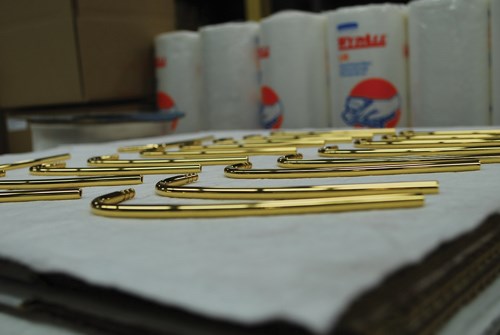Making the Medical Grade for Gold Plating
Gold plating delicate and micro parts involves more than just the gold plating process—extending to cleaning, rinsing, drying and inspecting the deposits on these difficult components, as well.
#medical #pollutioncontrol #masking
Gold plating services within the medical, electronic or telecommunications markets often involve the application of gold deposits on very small or micro parts.
In these industries, there is an ongoing emphasis on Swiss and micro machining of smaller and smaller components to meet design requirements. In turn, metal finishing suppliers need to be able to process increasingly smaller parts.
Featured Content
Gold plating delicate and micro parts involves more than just the gold plating process—extending to cleaning, rinsing, drying and inspecting the deposits on these difficult components, as well. Job shops need not only the proper process, but also adequate line and inspection equipment.
Ultrasonic cleaning is a process that uses sound energy to create cavitation of microscopic bubbles on a part surface. This mechanical energy, combined with the thermal and chemical cleaning effects of ultrasonic cleaning solution, makes for an extremely powerful cleaning tool.
Ultrasonic cleaning prior to gold plating of delicate parts—especially those with small ID holes and features—is critical to remove cutting oils, shop dirt and debris.
Advanced Plating Technologies (Milwaukee, Wisc.) uses various ultrasonic cleaning techniques generated from both piezoelectric and magnetostrictive generators for a full range of cleaning applications.
Proper Process Tooling
Both the process and tooling need to match the part to be gold plated. Several methods to plate micro parts can be used:
Traditional Barrel—This method uses a horizontal chamber that rotates during plating. The hole size (perforation) of the plating barrel needs to be small enough that parts will not get caught in the barrel wall. Barrel perforations as small as 0.010-inch can be used for gold plating of very small diameter components.
MPM Barrel—Minimum part movement barrel technology is a proprietary barrel plating technology that minimizes the ability of the parts to tumble and interlock. Advanced Plating Technologies helped pioneer this plating technology with Hardwood Line Manufacturing Co. (Chicago, Ill.). MPM allows for barrel plating of long, narrow pins and components often found in gold plating in the telecom or interconnect industries.
Vibratory Barrel—Vibratory plating originated in Switzerland with roots in the Swiss watch industry. A vibratory barrel utilizes mechanical vibratory energy to move parts over an electrode bed during plating. The vibratory energy also helps transfer plating solutions into the small inner diameters (ID) of delicate parts during plating, making this gold plating method an excellent choice for interconnect components such as female sockets where the functional area is in the ID of the part.
Proper rinsing is a key tenet of gold plating services for applications in joinability, including wire bonding, soldering and laser welding. A sound gold deposit can fail to solder or bond if the surface is contaminated due to poor rinsing.
As such, proper rinsing of gold plated parts—especially small and micro parts—is a critical step. Use of multiple high-quality water counter flow rinses, ultrasonic deionized water rinses and a final spray rinse of virgin deionized water are all techniques used by Advanced Plating to ensure cleanliness of the gold plated deposit.
Drying in a clean, stainless steel oven in a controlled environment ensures that residual water fully evaporates from the surface without contamination from the oven itself. Packaging of gold plated parts should be selected to protect the purity of the deposit during storage. Nitrogen bag packaging, Advanced Plating’s preferred method, is a specialized technique in which the air within a heat-sealed bag is extracted and back-filled with pure nitrogen prior to being resealed.
This protects the parts in an inert nitrogen atmosphere until they are used, thereby preventing oxidation of under-plates such as nickel from propagating to the surface of the gold deposit, and greatly extending the solderability or wire bonding shelf-life. This is especially critical when dealing with thin gold deposits below 0.00003 inch per side, where oxidation through the gold can occur more readily.
Inspection
Inspecting the thickness of a micro gold-plated component with x-ray fluorescence per ASTM B568 requires an x-ray with a collimator of a small enough beam size to focus on the features of the part.
Advanced Plating uses x-rays manufactured by Oxford, Fischer and CMI with collimators as small as 0.004 inch to enable inspection of extremely fine components. Deposit thickness readings to the micro-inch level are common and accurate with these tools.
Multilayer standards are also available in modern x-rays to inspect the thickness of multiple deposits such as gold plating over nickel without having to use coupons or pull parts after each step in the process. Adhesion testing and inspection under magnification is often required when gold plating micro parts.
Commonly, crimp and/or bake and quench tests per ASTM B571 are performed and inspected under 10-100x magnification to properly evaluate the deposit.
Without high-level magnification, minute failures or issues with the gold-plated deposit can be missed and overlooked.
Matt Lindstedt is the technical sales manager for Advanced Plating Technologies in Milwaukee, Wisc. He can be reached at mattl@advancedplatingtech.com. The company's website is AdvancedPlatingTech.com
RELATED CONTENT
-
Applications Innovation Leads to Better Masking Solutions
When masking product failures are costing you money, it pays to work with an expert that can select or engineer the most efficient solution.
-
Troubleshooting for Electrocoating
Characterizing the type of defect is essential in identifying the root cause and eliminating its source...
-
Are TGIC-Free Powder Coatings Right For You?
This alternative to TGIC-based polyester powder coatings offers similar performance and enhanced transfer efficiencies.





















